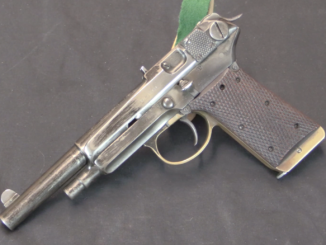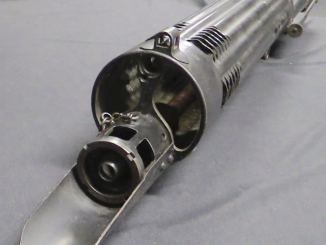Guns in this video:
S&W Navy model
S&W Pocket Model
Volcanic Navy model
New Haven Pocket model
The deep beginnings of the Volcanic go back to Walter Hunt’s Volitional Repeater, which became the Jennings repeating rifle, which then became the Smith-Jennings repeating rifle when Horace Smith was brought in to improve it. Smith was able to make it more commercially viable than the Jennings had been, but he recognized that the system needed significant changes to really become successful. He had met a fellow gun designer who had similar ideas, by the name of Daniel Wesson, and the two would spend a couple years developing and refining the system. In 1854 they thought it was ready for production, and formed the Smith & Wesson Company.
Included in the original company was a man named Courtland Palmer, who owned the patent rights to the Jennings system. Smith & Wesson’s system would probably have been deemed an infringement of Palmer’s patents, and by bringing him into the company they avoided legal trouble. The fact that he was a relatively wealthy financier of the new company certainly didn’t hurt!
The pistol that S&W started producing was a manually repeating one with a tubular magazine under the barrel holding either 6 or 10 rounds. It was available in the .41 caliber Navy model (note: not actually adopted by the Navy) and the .31 caliber pocket version. In this first iteration, both used iron frames, which were all engraved lightly. The prices were pretty steep, and the guns suffered from some reliability problems and a fundamental problem of underpowered ammunition (the .41 caliber had a muzzle velocity of just 260 fps / 79 m/s). However, they did offer a much greater level of rapid repeating firepower than the muzzle loading revolvers of the period, and gained some loyal fans. In total, just 1700 of the guns were produced before the company went bankrupt, about a year after forming.
To recover from that setback, they reformed the company into the new Volcanic Repeating Arms Company, and sold stock in the new company to generate a new supply of capital. This allowed them to get back into production, and the Volcanic company would make another 3000 pistols, all .41 caliber Navy types, before also running out of money 19 months later in 1856.
At this point, Smith and Wesson decide to move in another direction, and one of the main creditors of the Volcanic company is able to acquire all of its assets and put the guns into production a third time. The name of this creditor? None other than Oliver Winchester. Winchester puts a new infusion of his own money into the company under the name New Haven Arms Company. This company produces another 3300 guns, both large and small frame by 1861. The New Haven company comes very near to bankruptcy itself before finally changing the design to create the Henry repeating rifle. The Henry’s rimfire ammunition finally solved the reliability and power problems of the Volcanic, and became the starting point for Winchester to become one of the predominant American arms making companies.




“However, they did offer a much greater level of rapid repeating firepower than the muzzle loading revolvers of the period, and gained some loyal fans.”
I am not sure about that – both require some manual action beyond trigger pull to operate. Loading percussion revolvers with balls, powder and caps, surely need time, but some revolvers allowed fast switch of complete cylinder (Remington Model 1858).
“underpowered ammunition (the .41 caliber had a muzzle velocity of just 260 fps / 79 m/s)”
There is always problem in combining tubular magazine with handgun (or any other short weapon), this also is example than “shortening” rifle to automatic pistol size is often not viable option.
Do you have any contemporary evidence that cylinders were swapped out?As far as I can tell it is a present day myth, inspired by semiauto mags. Among antique firearms one never finds one frame and multiple cylinders purchased.
100 grains at 260 fps is only 15 ft•lbf. It begs the question if Smith, Wesson & Winchester actually tested the bullet/ball on something. I suppose that could be lethal at close ranges with the correct shot placement, since people are surprisingly fragile organisms in some ways, but I wonder if the Volcanic should be classified as a “less lethal” weapon… A ballistic gel test with similar qualities bullet/ball would be interesting.
Also, considering lower level of medicine 1850s, even “moderate” wounds might results in later death.
Hence why the only mass use was for crowd control.
The ability of the Volcanic, or more potent killing weapons like the black powder .22 long, to technically kill a long time after they were shot people would be pretty cold comfort when your opponent put you on the ground with a larger revolver despite the fact that you shot him ten times first.
And then the opponent loses his arm or leg to gangrene. Either that or one would have to invent poison coated munitions and violate international law!
The point of a handgun is not to kill eventually. Its point is to STOP the aggressor right now. This means taking his desire or ability to fight. Whether or not he later dies of infection is immaterial
Still, they are lovely weapons. Too bad Uberti or Pedersoli don’t make a repro in, say .22 LR just for plinking.
I agree. Since this pistol’s integral magazine takes a freakishly long time compared to the detachable box magazine of more modern handguns, I don’t think the ten round limit applies.
Let’s see: .22 LR overall length is 22,79 mm, thus stacking 10 will result in length of 227,9 mm of cartridges itself – as there must be also place for follower (this is proper term for tubular magazine xor apply to box magazines ONLY?) so it would be longer.
Oops, I meant to say that loading the tubular magazine took a longer time than changing a detachable magazine.
Or, you could just use .22 Short, since it would be just for plinking. On the other hand, even modern .22 Short would be much more lethal than the original rocket ball round. Third option would be to cheat a little a modify the lifter so that it would be compatible with variable length cartridges. Sadly, probably not big enough market demand for repros regardless, since you won’t see the Volcanic in many Westerns.
“you won’t see the Volcanic in many Westerns”
I agree, it appears in (Western-themed) video Call of Juarez as Volcano Gun: http://www.imfdb.org/wiki/Call_of_Juarez
The point of a handgun is not to kill eventually. Its point is to STOP the aggressor right now. This means taking his desire or ability to fight. Whether or not he later dies of infection is immaterial@
As with caseless ammunition experiments in the 20th Century, the major problem with the Volcanic arms was getting a breech seal. This was even more of a problem than with linen-cartridge capping breechloaders like the Sharps or Greene, as noted here;
While firing it arm’s length was probably a less harrowing experience than doing it from the shoulder, the lack of a proper breech-seal undoubtedly reduced muzzle velocity. How much the shorter barrel of the pistol affected this is difficult to determine, as of course black powder generally has a faster peaking burning/pressure curve than smokeless powder does.
cheers
eon
So how would you fire this thing one handed? Or could you? It looks like the lever goes pretty far forward so would you be able to work the lever with your middle finger? Probably not. And if you have to use two hands, why not just use a rifle?